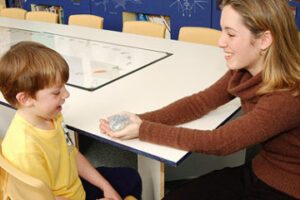
What is Applied Behavior Analysis or ABA and how can it help my child?
Applied Behavior Analysis (ABA) is a science in which specific procedures are systematically applied to improve socially significant behavior to a meaningful degree. ABA programs consist of carefully planned methodical teaching that involves breaking skills down into small, easy-to-learn steps. Carefully chosen reinforcement is used to increase motivation for positive behavior change, and environmental supports are deliberately arranged to increase the likelihood of positive behavioral choices. Program design is based entirely on individual strengths and weaknesses and individual motivational variables. Progress is continuously measured so the teaching program can be adjusted as needed. As skills are mastered and problem behavior is reduced, careful attention is paid to generalizing the use of positive skills to a variety of environments and supports are systematically faded.
ABA is widely recognized as the single most effective treatment for children with Autism Spectrum Disorder, leading to substantial, lasting improvements in their lives. However, ABA programs can be used effectively to build new skills and reduce problem behaviors with a wide variety of individuals, including those with behavioral disturbances, developmental disabilities, and those with no diagnosis or disability. The principles of ABA can benefit anyone! ABA-based treatment strategies maximize learning potential, and are flexible, individualized, and dynamic. Benefits of ABA have been consistently validated by independent scientific research. ABA is recommended and supported by the U.S. Surgeon General, the National Institute of Mental Health, National Institute of Child Health and Human Development, National Research Council, American Academy of Pediatrics, American Academy of Child and Adolescent Psychiatry, the American Academy of Neurology, NY State Dept of Health and many other national medical policy organizations and national professional medical associations.
How Do ABA Therapy Programs Work?
• Each individual’s specific skill strengths and deficits are identified and defined through thorough assessment (adaptive and maladaptive behavior scales, VB-MAPP). The function, or purpose, of each targeted problem behavior is determined through the process of Functional Behavior Assessment.
• Problem behaviors and needed skills are chosen and defined for the purpose of building individual problem behavior reduction programs and skill development programs.
• Specific goals are set based on the individual needs of the individual learner.
• Targeted skills to be taught are broken down into a series of manageable steps, making learning easier.
• Clients are provided multiple opportunities to practice and perfect each step of the target skill to mastery level.
• Successful use of target skills results in positive reinforcement, maintaining high motivation for development of new and difficult skills.
• Progress is constantly tracked through the systematic collection and evaluation of data.
• Programs include careful consideration of expanding the use of the new skills to multiple new environments with a variety of individuals and materials for maximum impact in daily living.
• Problem behavior is addressed through the lens of “why” it is occurring- the function of the behavior. The individual learns new appropriate behavioral pathways that can serve the same basic purposes as those of the problem behaviors.
• Parents are taught to implement behavioral strategies in their homes to support the overall goals of the individual client.
Common Targets For Intervention
• Self-stimulatory or repetitive behaviors
• Receptive/Expressive language
• Functional Communication Skills
• Joint Attention/Social Skills/Play Behavior
• Attention/Eye Contact
• Compliance with Parents/Teachers
• Non-verbal imitation
• Gross/Fine Motor Skills
• Potty Training
• Self-Help Skills (e.g., feeding, dressing)
• Preparation for participation in school
• Other problem behaviors (e.g., aggression, self-injury, tantrums)

